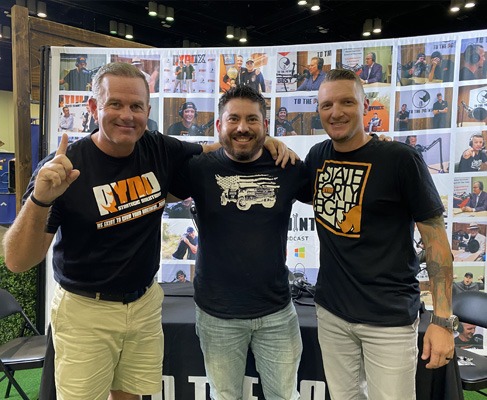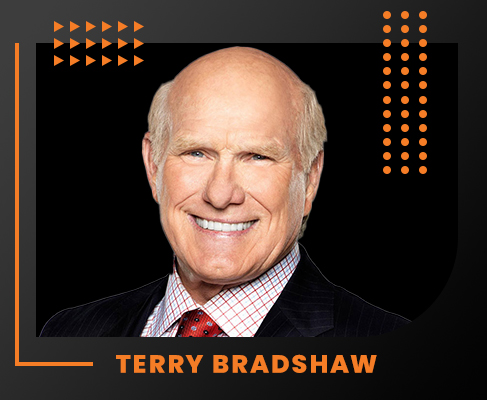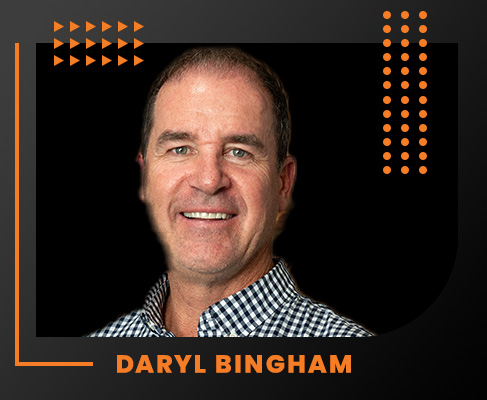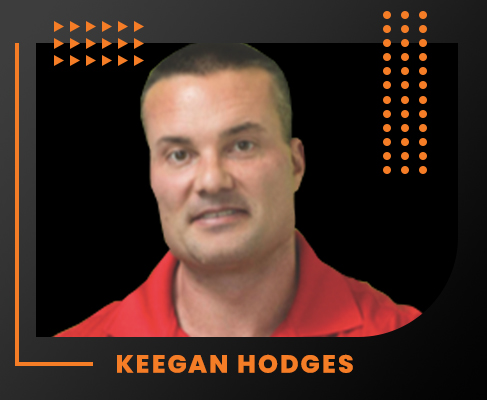There’s a new wave of contractors, and it’s not just in the roofing industry! John Dye, Executive Producer of the American Contractor Show believes there are two different types of contractors: the ones moving forward, and the ones getting left behind.
Whether you’re a roofer or in another trades industry, a similar trend is happening. There are a lot of new technologies, best practices, and business models that are changing the game. Are you at the forefront of your market, or are you letting your competition beat you to the punch?
4th Generation, Born and Raised American Contractor
John Dye was born and raised in the trades, and comes from 4 generations of contracting. His father was a general contractor, his grandfather was a mason, and his great grandfather was a blacksmith. In 2000, his dad decided to leave his business and move the family from Chicago, where John was raised, to Indianapolis. John’s dad wanted to make some extra cash but didn’t want to go back into full-blown contracting, and sort of stumbled upon roofing sales. John’s dad realized after learning a bit more of storm damage and roofing that he could pick it up pretty easily. After all, sales is sales!
As a young adult, John went in a bit of a different direction, at least in the beginning. He worked his way up through the world of car sales, eventually owning a few of his own dealerships. John would go on to sell his dealerships, however, and move with his wife to Columbus. That’s when he came back to the roofing industry. John was looking for work and had a friend who was a GM for a local roofing company, and joined their team during storm season.
Early Success
On his first day out selling roofs, John signed 9 contracts. That felt pretty good for having no previous experience selling roofing! Before long, John was learning the ins and outs. What he realized as he was getting insurance companies to give him their scopes, however, was that the process of the company he was working for didn’t seem to be that effective.
The company would take whatever the insurance company gave them, and then do all of the work. They’d build the roof and all of the related work, and then figure out their numbers later. That made the sales cycle weird, and most of the time the company wasn’t getting paid for a lot of the work involved. John grew up around sales, and doesn’t believe anyone should be working for free.
As John was going through all of this and seeing the line item estimates, he couldn’t help but wonder why they weren’t getting paid for everything they were doing? He started to ask the insurance company for extra things to compensate them properly, and didn’t realize that what he was doing was called supplementing. This quickly added up to an extra few thousand dollars each job! As other people in the office noticed this, they started giving John their files to work on. Sales reps were seeing John make an extra $1500 or so on each job, and after commission on ten jobs that adds up to quite a bit!
The Ultimatum
It turns out that John had worked out a niche that wasn’t unique to just his roofing company. Roofers all over simply weren’t getting insurance companies to pay for all of the work that was being done. They were working for free! So John started a 3rd party supplemental company in 2010. He began working with other contractors to help them better understand and handle supplementing to make sure they were getting paid for their work. John also started widening his career path, earning his adjuster’s license, starting another firm, and building a few homes.
While managing a roofing company, the owner pointed out to John that it was obvious he really liked to teach. John certainly did, and the thing he enjoyed most of all of his ventures was teaching other contractors how to do what he did. The owner, also a close friend of John’s, told him he needed to make a decision. Either John was going to run the company, or teach. This owner had branches all over the place and was running a 40 million dollar company, so this came from a good place. He simply recognized that John had a passion, and was pushing him in a direction that made sense.
Art of the Supplement and American Contractor Show
As a result of this ultimatum, John realized the owner was right. John had been traveling a lot and teaching at events, and really did enjoy it all. That’s how the Art of the Supplement was born.
Art of the Supplement
John would continue to travel around the country, training contractors how to around the country on how to do insurance scopes, how to write things out, and do it all correctly. The Art of the Supplement is designed to help other contractors by providing a comprehensive supplement training system. From proper claim documentation and understanding the claim process to ensuring better profits and lower overhead, it’s a unique supplemental training that has helped countless roofing contractors improve their businesses.
American Contractor Show
While the Art of the Supplement was growing and helping many contractors, it still had a relatively narrow focus. During COVID, John decided to start the American Contractor Show (ACS). ACS and Art of the Supplement have done some crossover podcasts and videos together, but the American Contractor Show deals with a wider range of issues and is focused on helping contractors on a broader scale. In early 2021, ACS partnered with Jim Johnson, Head Coach at ContractorCoachPro. From YouTube to TikTok, ACS celebrates, informs, and educates contractors all over the country. It’s all about giving back to the industry!
A New Era of Roofing
After working with many different contractors and being in the industry for a few decades, John has seen plenty of what works and what doesn’t. In the roofing industry specifically, he’s noticed something big that he thinks people are thinking about all wrong. Specifically, John believes that most contractors have a bad approach to the storm game. The problem is that most roofing contractors (and contractors in general) take on the role of advocate for the insured (the homeowner). That’s more of a role for a public adjuster. Contractors have focused on helping the homeowner get their claim approved, and that’s completely outside of the realm of what a contractor should be doing.
The Art of the Supplement took off because it was helping contractors understand the insurance claim process and supplementing better. It also was successful because contractors had a huge focus on filling this role of being the insured advocate. In 2021, the industry shifted. Now, insurance companies feel like roofing companies are at war with them. There is a shift because roofing companies have become better at supplementing, which cuts into the profit margins of the insurance companies.
Roofing companies not only have to fight to get paid for their full scope of work, but the sales cycle on insurance claims can be 3-5 months or longer. The actual work is usually done in a day, but then it takes months to get paid out. To compound matters, Insurance companies have shifted guidelines so that they have to cover less of the roof. What John has witnessed is that there are some savvy contractors who have come up with great solutions to many of these issues.
New Era vs. Legacy Model
John points to Jen Silver, owner of Roofing Utah as his example. Jen understands that the homeowner is often scared of the contractor knocking on their door, selling them the idea, getting the insurance company to pay for the project, and then taking that insurance check and running away with the money. This doesn’t happen often, but when it does, it’s all over the media. Jen brings a fresh perspective to the table. She explains to the homeowner that they are going to do the job based on the insurance check and finance the entire thing. Once the insurance company approves your roof, you’re going to take that money and put it in your bank account and keep it there until everything is figured out.
Jen does her own cost analysis with real numbers based on what things actually costs, not the insurance analysis. If the job is going to cost $12,000, and the insurance company is only going to pay $10,000, it will be clear. They create a full breakdown of the cost, and parse out any upgrades. Then the homeowner can take the actual invoice, what was actually paid, and bring that to the insurance company. There’s obviously other conversations that take place after (cost incurred, among others).
The old way is all estimates, and everything is nebulous. With this new way of doing things, it’s all in plain language and clear numbers. If the homeowner has any problems, they can simply call a public adjuster. The roofing job is completed, the finance company pays out, and a week later, Jen is out. Instead of 4-6 months, that sales cycle is 1-2 weeks max. This new model is what is being called “The Ultimate Claim Experience”. John is still traveling around teaching supplementing, but also bringing on Jen to explain her method. It’s probably costing John money, as it goes completely against a lot of the supplementing method, but it doesn’t matter. John is just focused on making contractors successful.
Addressing Pitfalls and Potential Problems
Whether you’re a roofing contractor, a plumber, or running a large HVAC company, most of what John has to say rings true. There is a paradigm shift happening across the trades, and if you are doing business like it’s the 80’s, you’re going to get left behind for sure.
Not Understanding What Your Customer Wants
We often do things a certain way out of a scarcity mindset. In many cases, that means assuming that the homeowner won’t want to finance things, or they don’t want a 2-stage furnace, or they won’t want to spend more for smart plumbing and brain pipes in their home. What often isn’t considered is what the customer actually wants. They might want to be able to still call you on a landline, but they might also prefer to chat online, fill out a contact form, or even use a platform similar to ordering a sandwich on DoorDash. Are you giving your customers options that they want, or just assuming you know best? Are you just doing things the way they’ve always been done because you think that’s what people still want?
Total Dependency on the Legacy Model
Sure, the legacy model for your business may have worked for decades before. Perhaps it’s a family business, and you’ve always done things a certain way. Call it tradition, or complacency, but at the end of the day if you aren’t looking towards the future as well, you can get left in the dust. We’re seeing things like offering leasing models in the HVAC world in addition to traditional payment and financing options. We’re seeing all kinds of new technologies and integrations in the plumbing and electrical industries. There’s no shortage of exciting new ideas and models, and refusing to look at what is ahead is the wrong approach altogether. It doesn’t mean you have to try every new idea that comes your way, but it should mean being willing to adapt and improvise to see what works best.
Not Making Enough Money
John believes that one of the major factors as to why the business owner isn’t evolving is simply that they aren’t making enough money. Other issues like lack of education are involved, surely, but really owners are usually the ones with the financial stress. Sales reps get paid, techs get paid, but the owners always feel tight on cash. They shouldn’t, but they do. The issue is they don’t know how to sell, they don’t understand their numbers, and are basically just cash flowing the business instead of actually having good numbers. Many of these companies have large revenue numbers, but they don’t understand their profit margins.
Are You Part of the New Era of Contractors?
Regardless of the industry you’re in, the information age will change it. Technology aside, we’re seeing plenty of podcasts, mastermind and best practice groups, and widely available resources that will help contractors grow. If you’re not part of the industry that is evolving and taking part in this new era, that’s a warning sign you can’t ignore.
If you’d like to connect with John, you can email him at [email protected].



